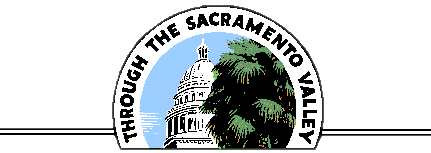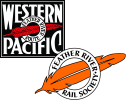BART "RIBBON" RAIL TRAINS:
LAST STAND OF THE COVERED WAGONS ON THE SN
The Bay Area Rapid Transit District, or BART was we know it today, used welded rail in 1,000-foot lengths which came from the Southern Pacific's "ribbon" rail facility at Tracy, California.
The advantage of welded rail, or "ribbon" rail as railroaders often call it, is that there are no joints every 39 feet. These joints cause both wheel and track wear. In fact, rails wear primarily at the joints, and it is common to cut the ends off when welding used rail together. Since rail wears only on the inside face, used rail is turned opposite to the previous installation when being welded. Welded rail also eliminates the clickity-clack of the wheels at the joints, making the trains much quieter.
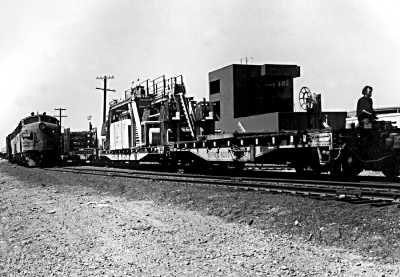
BART used 1,000-foot "ribbon" rails, though the industry standard is 1,320 feet. "Ribbon" rail's one major fault is that they can kink in hot weather, causing derailments. Where the 1,000-foot lengths are joined, there is an expansion joint. BART felt that the shorter rail lengths would alleviate the expansion problem. "Ribbon" rail cannot be laid in cold weather. The cold can cause the rails to separate, breaking train control track circuits.
Rails are measured by weight per yard. for example, the original Oakland & Antioch Railway rail was a mere 48 pounds per yard when the track was first laid from Bay Point to Lafayette in 1911. The Oakland, Antioch & Eastern, successor to the O&A, used 70 pound per yard rail to suit their larger and faster equipment. The greater the weight per yard, the greater the rail's strength. When the Western Pacific gained control of the OA&E/San Francisco Shortline in 1927, the rail from Lafayette to Pittsburg was replaced with used 85 pound rail. Termed "relay" rail, these rails were from the original Western Pacific track dating from 1906 and 1908. BART used 112 pound rail, a medium weight. Today most main line freight railroads use rail weighing between 132 to 136 pounds.
In early days, rail lengths were governed by the lengths of flatcars. For example, the WP relay rail was only 33 feet long to fit the 34 or 36-foot flatcars of the time. A lot of 1920-1940 rail was 39-feet long, since flatcars of the time had a 40-foot length.
In the United States, standard gauge is 4 feet, 8 -1/2 inches, or 56 -1/2 inches. BART is broad gauge, 5 feet, 6 inches or 66 inches. In days past, some railroads were also built to narrow gauge, with 3 feet being the most common. San Francisco's famous cable cars are 3-1/2 foot gauge, or 42 inches. In some foreign countries meter gauge is common, which is 39-3/8 inches.
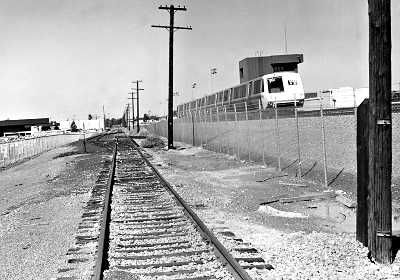
The Sacramento Northern is standard gauge, compatible with nearly all other U.S. common carrier railroads. Because BART was broad gauge, the "ribbon" rails were transfered from the SN to special dollies on BART track via a special piece of track from the SN to BART's right-of-way. The location of this special track was near SN milepost 32 in Concord. This was located just off Detroit Avenue behind the PG&E corporation yard. This was once known as Kilgore, or Kilgore Ranch, and was stop for the SN school trains. The rail trains were picked up from the Southern Pacific at McAvoy near West Pittsburg and hauled through Port Chicago and Concord to the BART yard.
I did see and photograph two such SN/BART "ribbon" rail trains in June 1971, but wouldn't be surprised if there were several more of these trains. I also saw bulletins issued by the SN to its operating personnel to have SN "covered wagons" 301A and 301D, the line's two General Motors Electromotive Division model F-3 locomotives, available to move the "ribbon" rail trains. Unfortunately they were transfered to the WP in May 1971 to be traded in on new locomotives for the WP, not the SN. So in June, the SN had to use whatever engines the WP could spare.
Train #1 looked like this: WP 915-D, an EMD 1,500 horsepower F-7 "covered wagon"; WP 2010, an EMD 2,000 horsepower GP-20 road switcher; SN 405, an ALCO 660 horsepower S-1 switcher; and special flatcars loaded with 1,000 feet of rails.
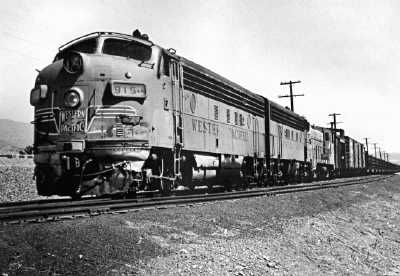
Train #2, the "California Zephyr came to Concord" train, was headed by WP 915-A, an EMD 1,500 horsepower FP-7 "covered wagon". This locomotive was formerly WP 804-A, a passenger locomotive that powered the famed "California Zephyr". At one time she had 95 miles-per-hour gears, but was now regeared for freight train speeds. The second locomotive was again WP 915-D, followed by SN 407, a Baldwin Locomotive Works 1,000 horsepower VO-1000 switcher. Behind the rail cars was SN's green caboose 1632.
The hard part of this was to move these trains over Ohmer Hill in North Concord. The grade began at the entrance to Diablo Creek Golf Course and continued to where the BART North Concord depot is now. With both trains a second run at this hill was necessary, as the first attempts failed. When the trains backed down, the rails were sanded as they had been going forward.
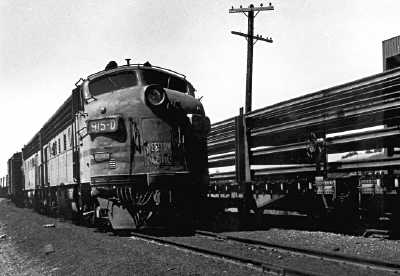
Most of WP's "covered wagons" did not last much beyond one or two more years before being traded in on new locomotives. The notable exception was four F-7s which were still on the roster when the WP was merged into the Union Pacific in 1983. All four of these beautiful locomotives were preserved in museums. One is in regular passenger service at the California State Railroad Museum in Sacramento, and another operates at the Feather River Railroad Museum in Portola.
